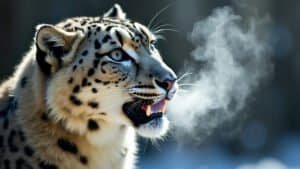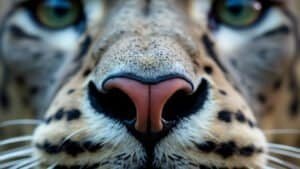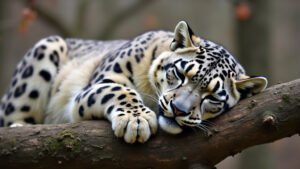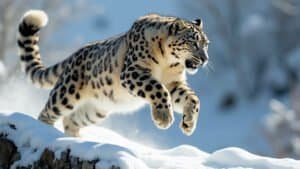Up in the cold, high mountains of Central Asia, one animal survives where most can’t: the snow leopard. With freezing winds and snowy peaks all around, how does the snow leopard stay warm? The answer lies in its amazing fur.
In this article, we’ll explore how the snow leopard’s dense insulating coat, long furry tail, and fur-covered paws help it survive in extreme cold. You’ll learn how their body is built for warmth, how their fur works like nature’s best winter jacket, and why these mountain predators are perfectly adapted to life in the snow.
Snow Leopard Fur Adaptations for Extreme Cold
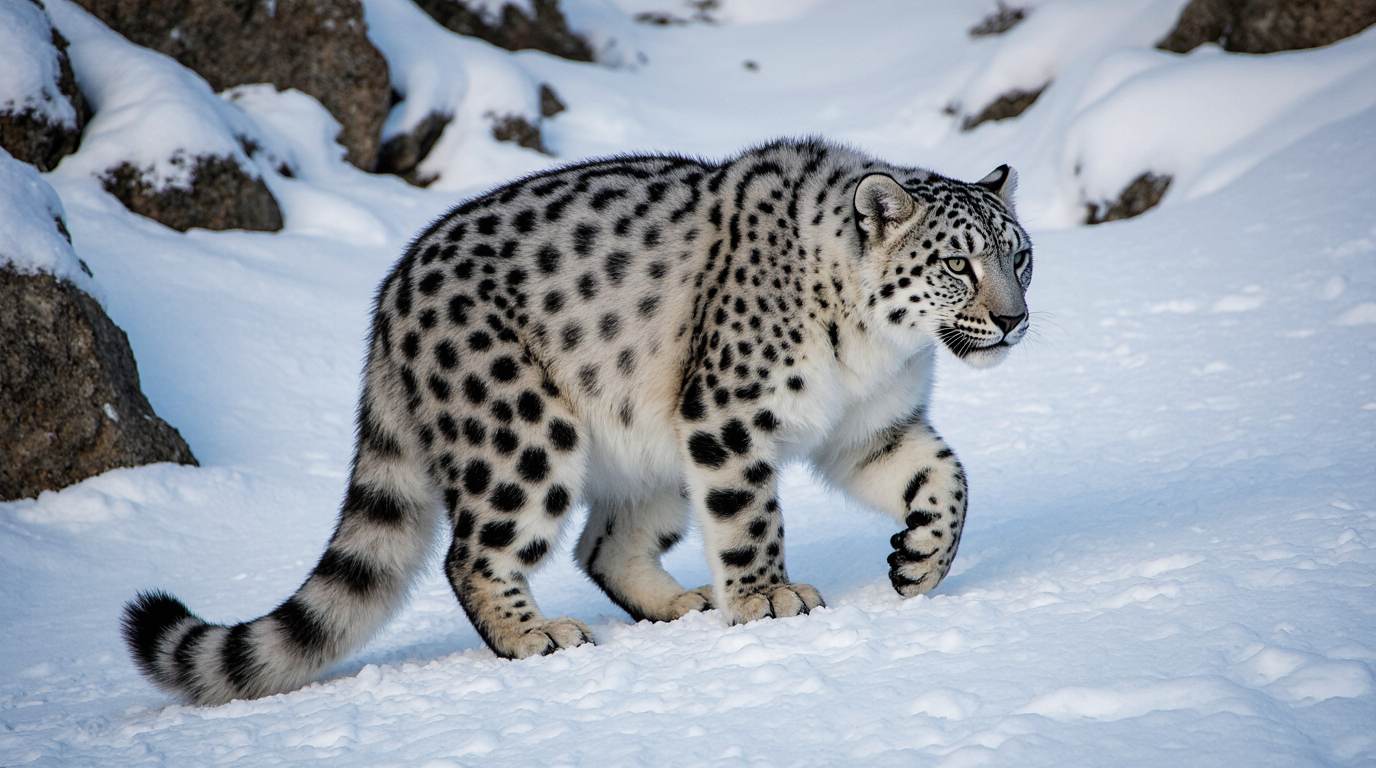
Snow leopards live in freezing mountain ranges where temperatures can drop far below zero. To survive in this cold, they rely on special fur adaptations. Their coat doesn’t just look fluffy—each part has a job.
It keeps heat in, blocks out cold wind, and even helps them move across deep snow. Let’s explore how the layers of their fur, their tail, and their paws all help keep them warm and alive in their icy home.
The Two Fur Layers and Their Thermal Function
Snow leopards have a double-layered coat. The inner layer is a dense under-fur that traps warm air close to the body. This layer is soft, thick, and acts like a thermal blanket. On top of that lies the outer coat made of longer guard hairs. These guard hairs protect the under-fur from wind, snow, and water.
The under-fur works by trapping body heat and holding it near the skin. It creates a pocket of warm air that keeps the snow leopard warm even when the air around it is freezing. The outer guard hairs help to shield this warm layer by deflecting snow and reducing the chilling effects of wind.
In winter, this fur becomes even thicker. The coat can grow up to 5 inches long, especially around the belly and chest. This extra growth boosts insulation just when it’s needed most. Snow leopards don’t migrate or hibernate—they stay active all year. That means their fur must be reliable no matter how cold it gets.
This two-layer system gives the snow leopard one of the warmest natural coats of any big cat. It lets them survive in places where few animals can. You can explore more about these physical features in the Snow Leopard Trust’s guide to their body—a helpful look at why every part of this predator’s body is built for the mountains.
Tail and Belly Fur for Maximum Insulation
One of the snow leopard’s best tools for warmth is its thick, furry tail. It’s not just for balance—it’s like a built-in scarf. When resting or sleeping, the snow leopard wraps its tail around its body or face to trap heat. The fur on the tail is as thick and long as the fur on the belly and sides, helping to reduce body heat loss.
The tail is especially useful because it covers parts of the body that lose heat quickly, like the nose and paws. When curled up, the snow leopard looks like a snowball—with its tail wrapped tightly around, acting like a barrier against the cold mountain air. This helps protect its most delicate areas from freezing.
Likewise, the fur on the belly is extra thick. This matters because the belly often touches cold surfaces like snow or frozen rocks when the animal lies down or crouches. Without this insulation, body heat would quickly escape into the cold ground.
These thick fur zones—belly and tail—are part of the snow leopard’s survival system. Together, they stop the cold from creeping in during long mountain nights or while resting between hunts.
Thick Paws Fur: Natural Winter Boots
Take a look at a snow leopard’s paws and you’ll notice they’re massive and round. That’s not just for walking—it’s for warmth. Under each paw is a thick layer of fur that acts like natural snow boots. This padding protects the snow leopard from the cold snow and ice it walks on every day.
The fur also keeps snow from sticking between the toes. If snow builds up, it can cause frostbite or make walking painful. But this furry layer keeps the snow out and keeps the paw pads dry and warm. It’s one of the key adaptations that allow snow leopards to move freely across icy slopes without injury.
In addition to insulation, the fur helps spread out their weight. This means they can walk over soft snow without sinking deeply. The effect is similar to snowshoes worn by humans. These big, fur-covered paws make them silent, stealthy hunters even in the snowiest terrain.
Want to learn more about their survival skills in icy mountains? Check out how their thick paw pads help in cold habitats and how their whole body is built to deal with snow, cold, and rocky terrain.
Physical Features That Help Retain Heat
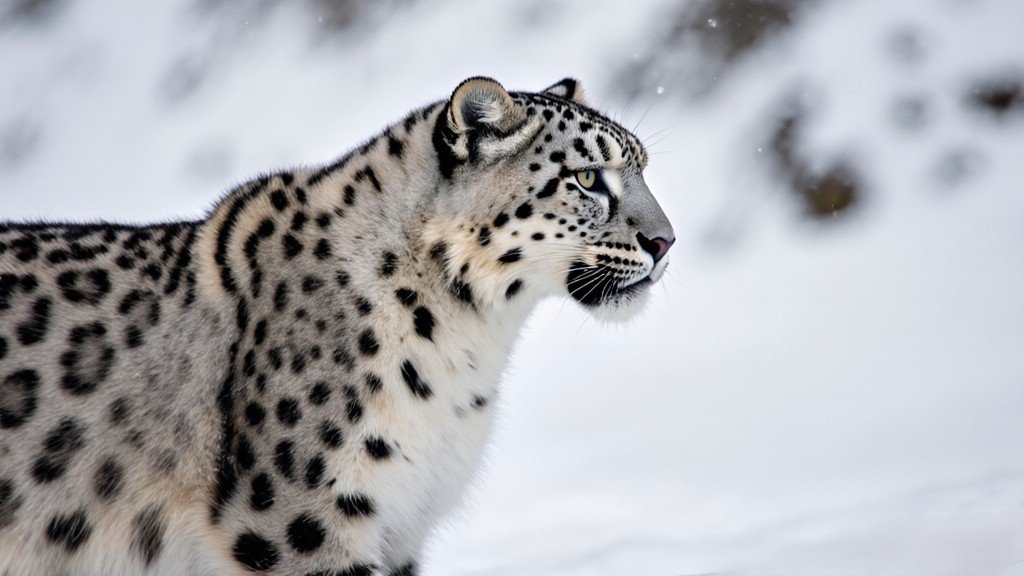
The snow leopard’s fur isn’t the only thing keeping it warm. Its whole body is shaped in a way that helps it stay cozy even when the weather gets freezing. From its round ears to its compact body and snowshoe-like paws, every part of the snow leopard is adapted to survive cold mountain life.
Let’s take a closer look at how these special features help conserve heat and energy.
Compact Body and Rounded Ears Reduce Heat Loss
Snow leopards don’t just have thick fur—they also have a body shape made for warmth. One key feature is their small, rounded ears. Unlike large ears that lose heat easily, their ears stay close to the head and don’t stick out much. This keeps the cold wind from drawing heat away from their body.
Another big advantage is their compact and stocky build. Snow leopards have short legs, a broad chest, and a thick body. These traits lower their surface-area-to-volume ratio, which means they don’t lose heat as fast as animals with long limbs or thinner bodies. Less surface area means less exposure to cold air.
Their thick chest also helps warm the air they breathe. In high-altitude places, the air is dry and cold. But the snow leopard’s wide nasal passages help heat and humidify air before it reaches the lungs. This makes breathing easier and keeps their body from getting too cold.
All these features work together like parts of a heating system. They help trap warmth, limit exposure to freezing air, and make it easier to survive at high elevations.
How Paws and Tail Shape Support Warmth
You already know the snow leopard’s paws are furry. But their shape matters too. Each paw is large and wide, giving the animal extra surface area to walk on deep snow without sinking. These “natural snowshoes” also help keep them warmer by limiting how much cold snow presses directly against the skin.
Their thick, flexible tail is also shaped to help with heat retention. It’s nearly as long as the body and covered in soft, dense fur. The snow leopard wraps this tail around its body or face when resting, like a scarf. This protects parts of the body that lose heat fast, such as the nose or paws.
The tail’s shape makes it easy to wrap up like this, and its softness adds comfort and warmth. It acts like a fluffy blanket, blocking cold wind and locking in body heat. Without a tail like this, the snow leopard would lose warmth quickly while lying on rocks or sleeping in the snow.
This smart use of tail and paw shape is a key reason the snow leopard doesn’t freeze in the mountains.
Snow Leopard Fur Density vs. Other Big Cats
Compared to lions, tigers, or leopards, snow leopards have one of the densest fur coats of any big cat. This isn’t just for looks—it’s a life-saving feature. Their under-fur contains thousands of hair strands per square inch. This traps warm air and holds it next to the body.
While a tiger’s coat is thick, it’s made for forest and jungle conditions—not snowy mountains. Tigers have longer but less dense fur. In contrast, snow leopards need fur that can handle icy winds and deep snow. That’s why theirs is both long and super dense, especially in winter.
Snow leopard fur also tends to grow thicker around the belly, chest, and tail—places where extra warmth is needed. Other big cats don’t need this because they live in warmer climates.
So if you compare the two, snow leopards have fur built for extreme cold. Tigers and lions have coats built for milder conditions. The snow leopard wins the fur battle when it comes to surviving freezing mountain weather.
For more comparisons and info on their cold-climate design, check out this detailed guide on how snow leopards survive harsh environments.
Surviving the Himalayan Temperatures
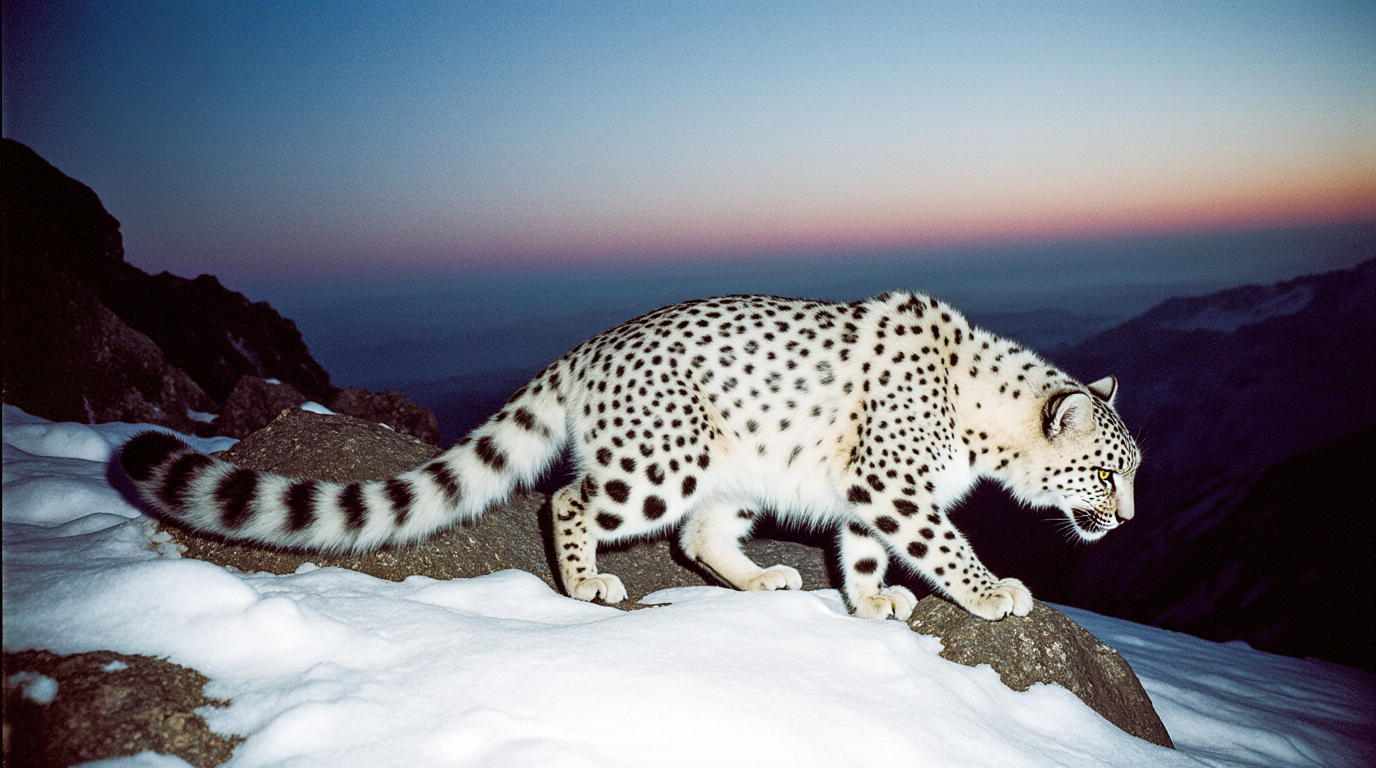
The snow leopard doesn’t just handle chilly weather—it thrives in places where temperatures drop far below zero. In the high-altitude zones of the Himalayas and Central Asia, it stays active year-round.
But how low can the temperature go before it’s too cold? What makes their coat strong enough to protect them in such extreme conditions? In this section, we’ll look at the science behind how their fur holds up against winter and what seasonal changes help them stay warm all year long.
Minimum Temperatures the Fur Can Withstand
Snow leopards live at elevations from 9,800 to 17,000 feet, where temperatures can drop to –40°F. Their coat is designed for this kind of cold. The dense under-fur layer locks in heat, while the longer outer hairs shield against icy wind and snow.
Studies and field reports show that even in the coldest regions, snow leopards remain active. They don’t hibernate or hide in dens all winter. This proves how effective their fur is in extreme cold. The outer guard hairs resist moisture and help keep the inner layer dry, even in snowstorms.
In very cold conditions, losing body heat quickly can be dangerous. But the snow leopard’s fur reduces this risk. It’s like wearing a super-insulated parka. Thanks to this coat, they can hunt, climb, and sleep outside even when the air is well below freezing.
They also rely on body heat conservation techniques, like curling into a ball and wrapping the tail around the face. Their coat keeps this heat inside. That’s how they survive in the wildest, coldest places on Earth.
Seasonal Fur Growth and Thickness Changes
Like many cold-weather animals, snow leopards grow a thicker coat in winter. Their summer coat is shorter and less dense. As fall approaches, the fur begins to grow longer, thicker, and fluffier. This change helps prepare them for the colder months ahead.
By mid-winter, the belly and tail fur can be nearly 5 inches long. This thick coat acts like insulation, holding in body heat even when the temperature drops fast. In warmer months, the leopard sheds much of this fur. That’s how they stay cool in the summer without overheating.
The seasonal change is triggered by daylight and temperature shifts. As the days get shorter and colder, the body signals the need for a warmer coat. In spring, as the weather warms up, this thick fur is no longer needed, and it begins to shed naturally.
This cycle means the snow leopard always has the right coat for the season. It saves energy and helps them stay comfortable all year.
Microclimates Created by Fur Layers
One of the most fascinating things about the snow leopard’s coat is how it creates its own microclimate. Between the thick under-fur and the outer guard hairs, there’s a layer of trapped air. This still air stays warm because it’s held close to the body.
The outer hairs block cold wind and snow from disturbing this warm layer. The result is a small zone of warmer temperature right against the skin—just like a high-quality insulated coat. This microclimate makes a huge difference in extreme conditions.
Even in wind or snow, the snow leopard doesn’t feel the full chill of the outside air. The warm air in the fur layers acts like a shield. It keeps the internal temperature stable, even when the environment changes quickly.
This insulation system lets them climb snowy cliffs, rest on frozen ground, and roam without losing too much heat. It’s one of the best natural designs for staying warm in wild, high-altitude environments.
Does Color and Pattern Affect Insulation?
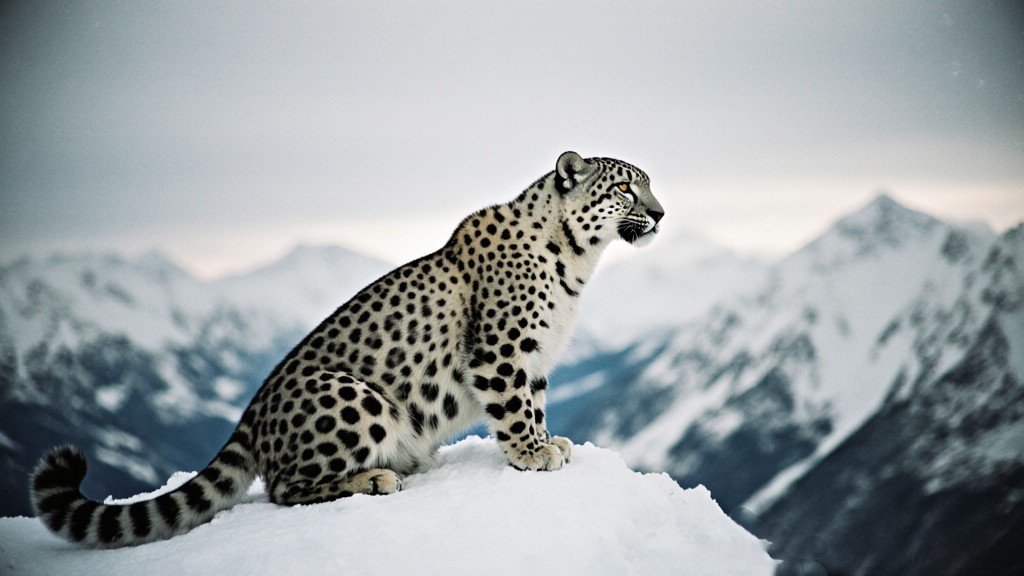
The snow leopard’s spotted coat is more than just beautiful—it’s also important for survival. Its pale gray base and dark rosettes help it blend into rocky, snowy environments. This camouflage protects it while hunting and hiding.
But does the color or pattern help keep the snow leopard warm too? Let’s dig into how much their coat appearance affects heat retention and what it really does.
Camouflage vs. Heat Absorption
The snow leopard’s coat color helps it disappear into the snowy, rocky terrain. This gives it a big advantage when stalking prey or avoiding danger. But when it comes to warmth, the color does less than the structure of the fur.
The pale gray and light tan colors reflect more sunlight than dark fur would. That means their coat doesn’t absorb much solar heat. If they had black or very dark fur, they might warm up faster in direct sunlight. But snow leopards don’t rely on sunlight for warmth. They count on the insulation power of their thick fur instead.
Also, snow leopards are active during early morning and evening, when the sun is weak or low. So heat from sunlight doesn’t play a big role in keeping them warm. Their survival depends more on their dense undercoat and layered fur than on any heat-absorbing color.
So while the pattern helps with hunting, it doesn’t really help with staying warm. Their fur’s color is more about hiding than heating.
Role of Coat Color in Cold Climates
In nature, some animals use dark colors to stay warm—like black bears or dark-feathered birds in polar zones. But the snow leopard’s environment is unique. It spends time on rocky ledges and snowy slopes, where staying hidden is more important than soaking up sun.
Their pale coat prevents them from standing out in these places. It’s all about blending in. Plus, their fur is so thick that sunlight barely reaches the skin underneath anyway. Even if the fur was dark, most heat would be blocked by the dense layers of hair.
The insulation from their coat comes from fur density, hair length, and trapped air—not color. So in this case, the snow leopard’s light fur does its job in camouflage, while its thickness does the job of keeping it warm.
Their body is a perfect match for their cold, quiet world—camouflaged to hunt and insulated to survive.


